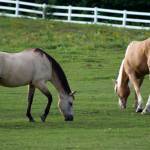Stereotypies in Horses: Feeding Management Among Likely Causes

Have you ever watched in disbelief as a horse clamps his incisors on a fence board, arches his neck, and heaves back? Or wondered quizzically why your favorite brood matron, flea-bitten with age, weaves frantically, her head swinging in time, when stress descends upon her? A group of researchers in Brazil recently set out to summarize the primary risk factors associated with the development of stereotypies in horses.*
In order to do this, the researchers reviewed scientific literature. Though more than 100 studies were identified in the initial search, further screening reduced the final number used in the review to 19. Those studies were performed in eight countries and involved nearly 19,000 horses of various breeds and uses.
About 26% of horses had at least one stereotypy or abnormal behavior. In order of prevalence, the most common stereotypies identified in the studies were weaving, cribbing, stall-walking, and windsucking. Others included pawing and stall-kicking. The most frequent abnormal behaviors reported in these studies were wood-chewing, manure-eating, and consumption of bedding.
As to the causes of stereotypies, the conditions most cited in the studies included:
- Feeding high levels of concentrates (19 studies),
- Reduced feeding time (18 studies),
- Confinement or insufficient time in a paddock or pasture (18 studies),
- Limited forage (18 studies), and
- Social isolation (14 studies).
Other factors thought to influence stereotypies or abnormal behaviors included stall design, exercise frequency, number of daily meals, weaning, proximity to other horses, boredom, frustration, and pain.
According to the review study, limited access to forage is the primary factor related to the development of stereotypies and abnormal behavior in horses, though multiple biological and environmental factors are likely at play in any given instance.
With this in mind, horse owners should be cognizant of the quality and quantity of forage they provide their charges. Because horses should be fed as individuals, these parameters can differ considerably depending on age, weight, work intensity, and metabolic status. With this in mind, every attempt should be made to mimic a horse’s natural grazing behavior by affording access to forage whenever possible.
Lack of forage is a common cause of gastric ulcers, which leads to discomfort and the possible development of stereotypies. If a horse is suspected of having gastric ulcers, a gastroscopy should be performed by a veterinarian to verify the diagnosis. Once gastric ulcers are cleared through the use of omeprazole, susceptible horses should be offered a research-proven supplement designed specifically to prevent formation of new ulcers.
*Seabra, J.C., J.R. Dittrich, M.M. do Vale. 2021. Factors associated with the development and prevalence of abnormal behaviors in horses: Systematic review with meta-analysis. Journal of Equine Veterinary Science 106:103750.








